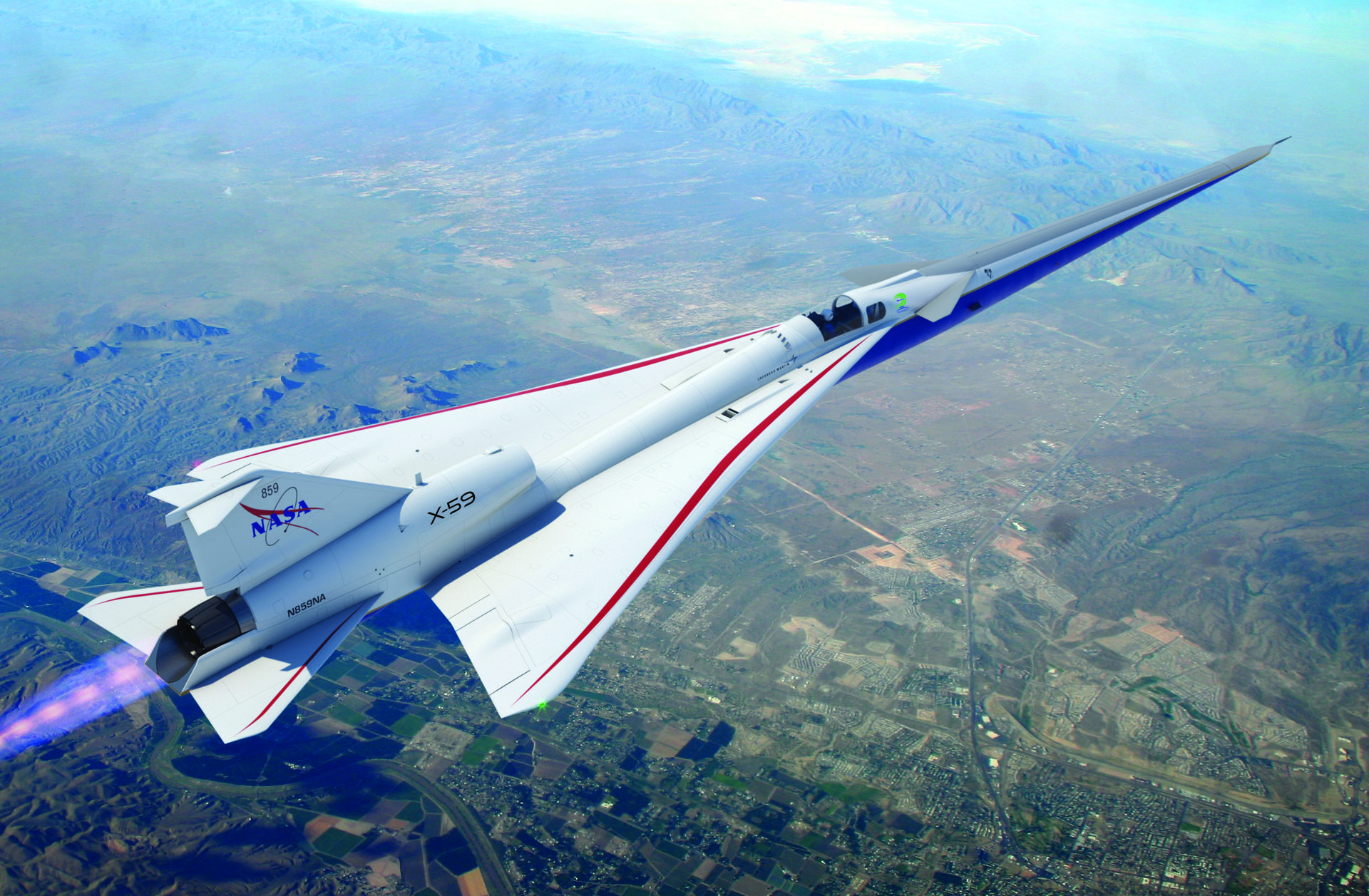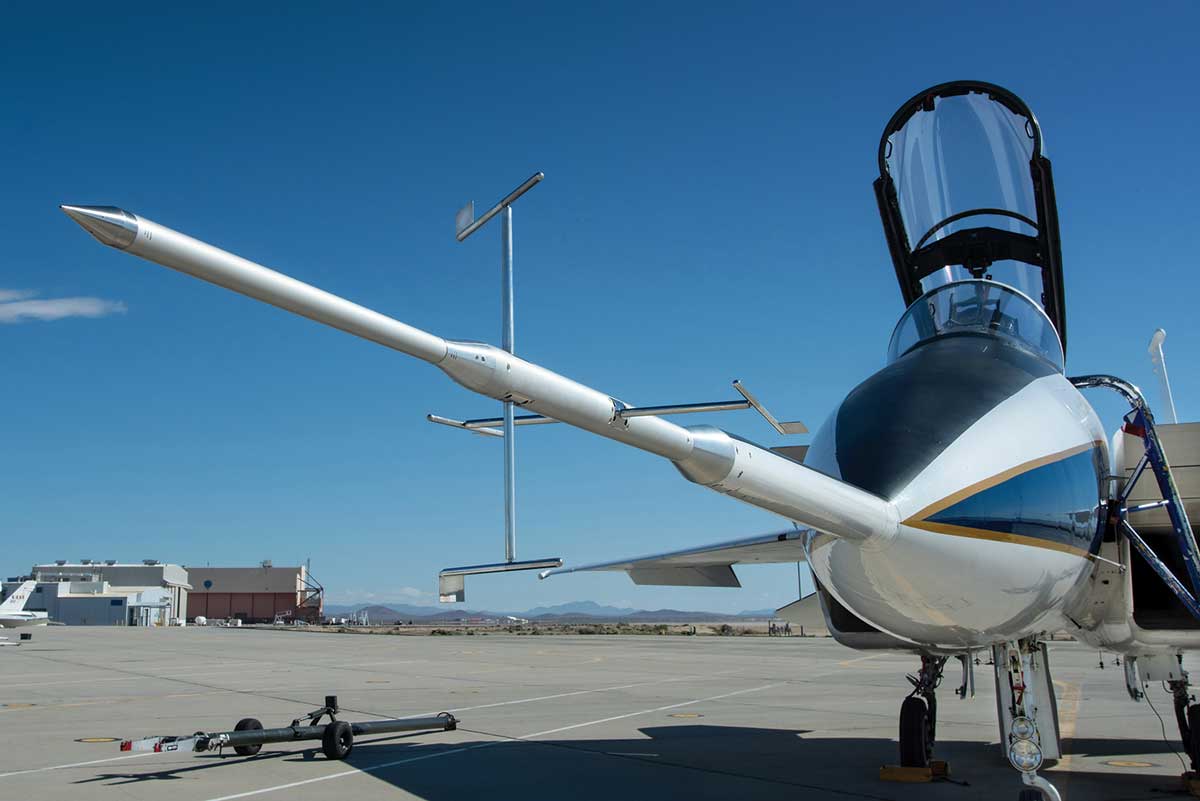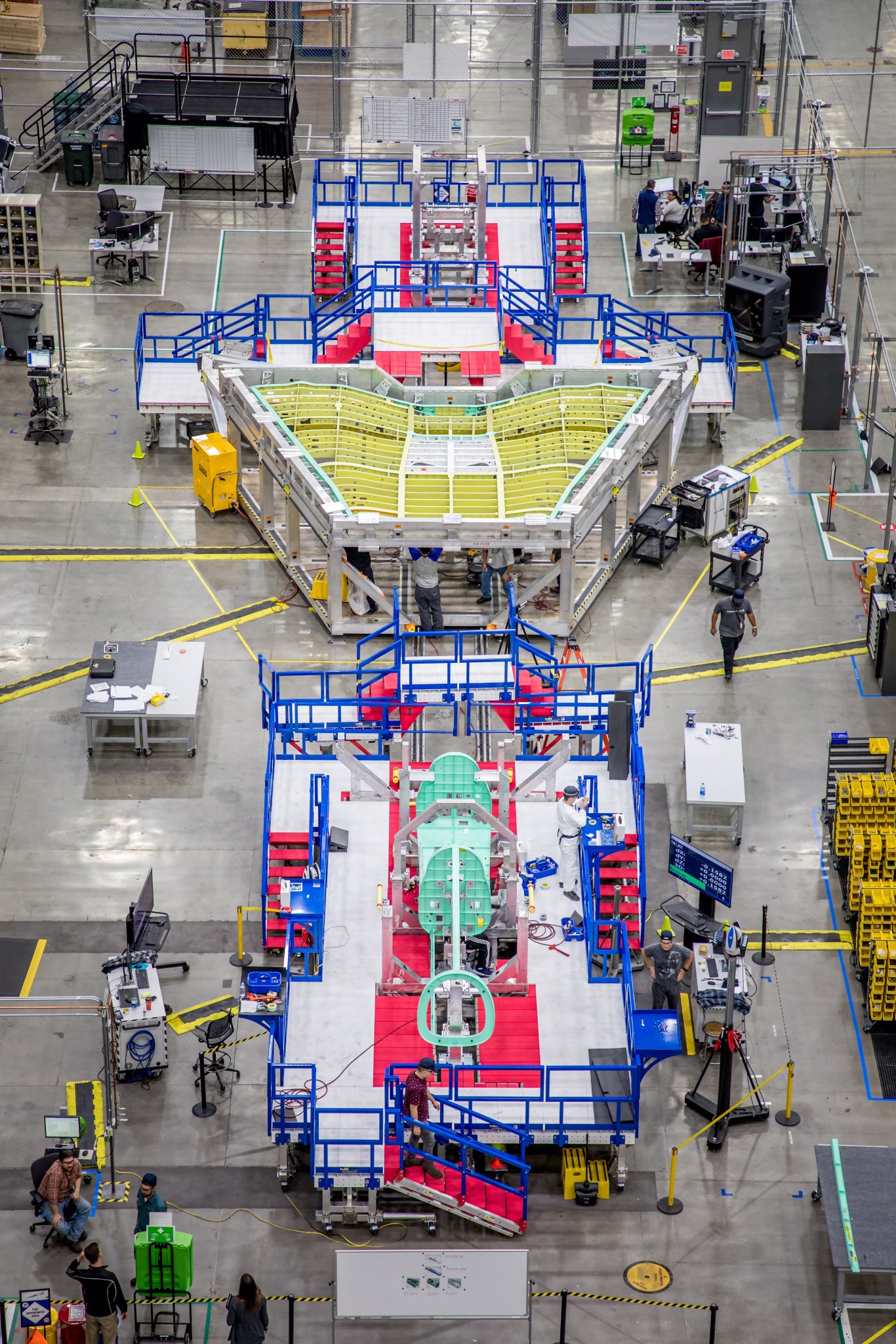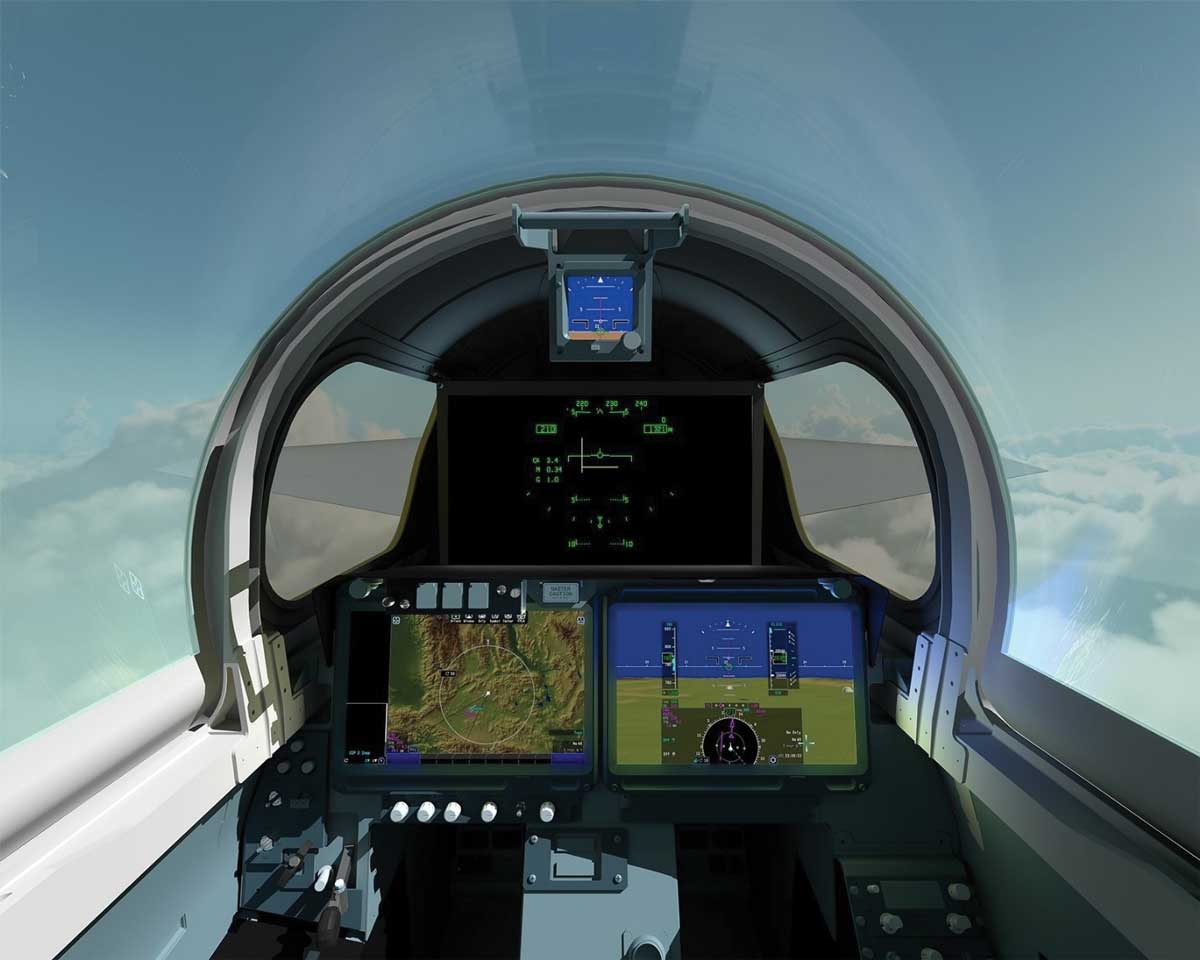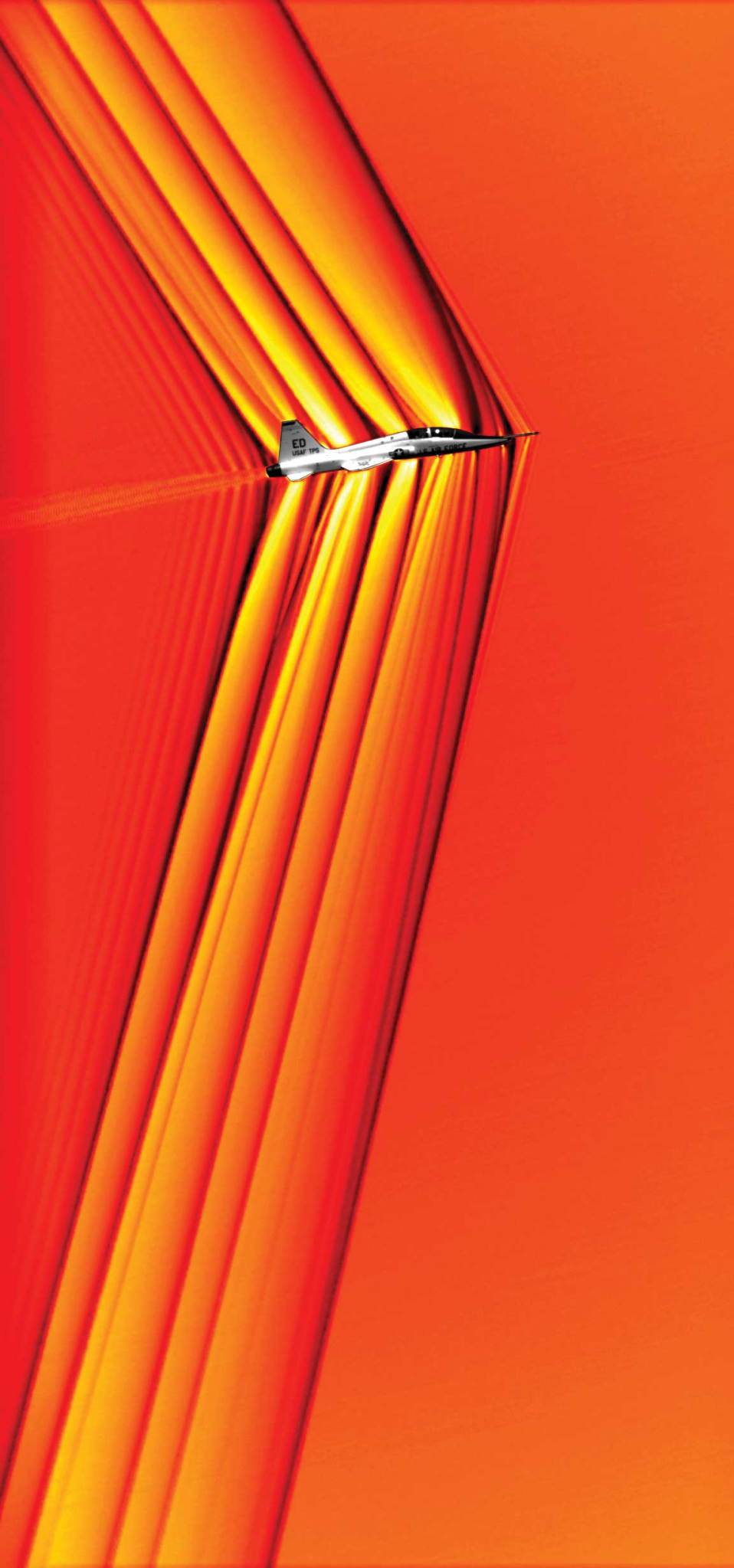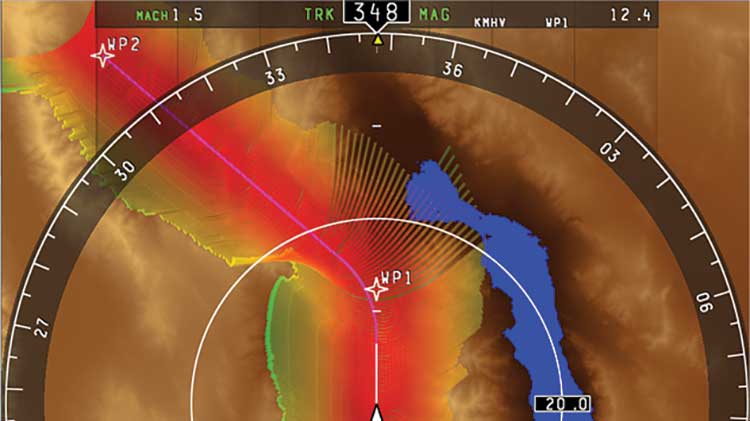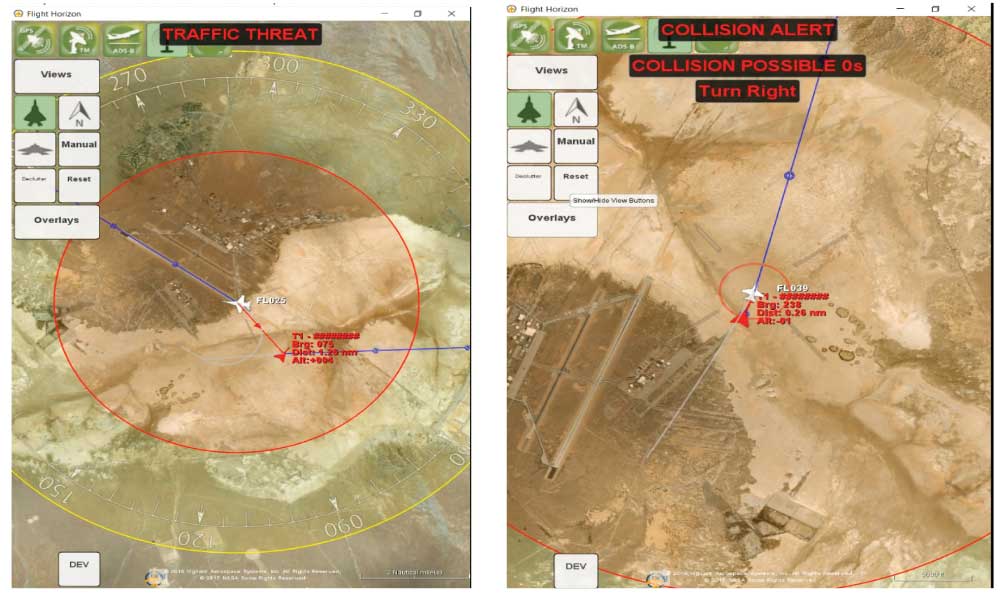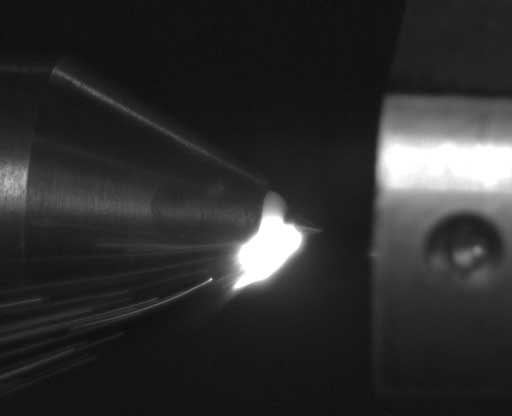Supersonic flight overland is currently severely restricted because sonic booms created by shock waves disturb people on the ground and can damage property. Innovators at Armstrong are working to solve this problem through a variety of innovative techniques that measure, characterize, and mitigate sonic booms. NASA’s goal for sonic boom research is to find ways to control and lessen shock wave noise so that federal regulators will allow supersonic flight overland.
The development of a new experimental plane called the X-59 QueSST—which stands for Quiet Supersonic Technology—is advancing as part of the Low-Boom Flight Demonstration mission. When the new X-plane arrives from Lockheed Martin Aeronautics Company’s Skunk Works® plant, Armstrong researchers will qualify and flight test it. QueSST will be used to help gauge how people respond to the lower intensity “thump” rather than the disruptive sonic boom in different areas of the United States. Determining a tolerable level of noise for supersonic flight is key to suggesting that the Federal Aviation Administration (FAA) amend its current rules for supersonic aircraft. Success could lead to opening a new market for next-generation aircraft.
Shock-Sensing Probe
A new shock-sensing probe in development at Armstrong is expected to provide researchers with key information about sonic booms. The Armstrong probe is mounted on the nose of an F-15B aircraft that flies through the shock waves of another supersonic aircraft. In addition to measuring the static pressure change through the shock waves, the probe measures the change in Mach number and flow angularity. Researchers are comparing these measurements to computational fluid dynamics (CFD) models to verify those predictions. If successful, the probe will be used for the Low-Boom Flight Demonstration mission.
Work to Date
In 2018 and 2019, the team flew five flights with the shock-sensing probe on the nose of the F-15B aircraft. Three of those flights were to calibrate the probe, and the other two were to measure the shock signature of an F/A-18 aircraft. The team encountered and addressed minor instrumentation issues. Thus far, the comparisons between the flight measurements and CFD models have been favorable.
Looking Ahead
The team is redesigning a portion of the probe to aid with assembly and disassembly. This modification is solely to make it easier to maintain the probe and will have no effect on probe measurements. Phase 2 flights are scheduled for late spring to early summer 2020.
Partner
Eagle Aeronautics
Benefits
- High performance: Measures flow speed, static pressure, and angularity
- Improves measurement: Allows for probing to be conducted at a higher closure rate, due to reduced pneumatic lag
Applications
- Facilitating aircraft design that may ultimately enable overland supersonic flight
PI: Mike Frederick | 661-276-2274 | Mike.Frederick-1@nasa.gov
X-59 Quiet Supersonic Aircraft
The Low-Boom Flight Demonstration mission seeks to enable the possibility of boarding a commercial supersonic airliner and flying across the United States in half the time it takes today. To support this goal, NASA is developing the X-59 Quiet Supersonic Technology (QueSST) airplane, whose unique shape and technology are designed to turn sonic booms associated with faster-than-sound flight into barely perceptible sonic thumps. Armstrong researchers are making significant contributions to this project, particularly in the areas of studying, characterizing, quantifying, and measuring sonic booms as well as work with an external vision system, which is necessary due to the plane’s unusual design. These achievements are highlighted below.
The X-59 will be flown above select U.S. communities to measure and record public response to its noise while flying supersonic. The resulting statistically valid data will be used to consider changing the regulation to be based on an acceptable sound level rather than a prohibition that has been in place since 1973. Construction of the X-59 by Lockheed Martin Aeronautics Company continues, and the project passed its Critical Design Review in October 2019 and another key program management review in December. By the end of 2019, the airplane was taking shape on the factory floor.
Assembly work is concentrated within three major sections of tooling. The forward jig is home to the X-59’s fuselage, the center section to the airplane’s single-piece wing, and the rear jig is set up for the fabrication of the airplane’s tail holding the vertical fin and the horizontal stabilizer—a section also known as the empennage. Final assembly and integration of the airplane’s systems is targeted for late 2020.
Initial flight tests at Armstrong in 2021 will ensure the vehicle operates well and will be followed by a series of supersonic flights to validate if it is producing quieter sonic booms as expected. After that, the X-59 will begin its community overflights to gather public response data, with the plan to present that information to the Federal Aviation Administration and others in 2023.
PI: Heather Maliska | 661-276-2843 | Heather.A.Maliska@nasa.gov
Skunk Works is a registered trademark of Lockheed Martin Corporation
Low-Boom Vehicles
Armstrong innovators are developing guidelines and evaluating stability and control characteristics for the planned supersonic Low-Boom Flight Demonstration mission. NASA is working to develop aircraft that can fly at supersonic speeds and deliver a soft thump instead of the disruptive boom associated with supersonic flight today. In addition to stability and control evaluations, Armstrong researchers are developing a supersonic autopilot to control aircraft parameters, such as the flight path and changes in Mach speeds to prevent coalescence of shock waves and minimize perceived sonic boom noise levels on the ground.
Work to Date
Armstrong researchers have developed a pilot-in-the-loop and batch non-linear simulation based on the initial models. The team has used the simulation to analyze vehicle stability, controllability, and handling qualities and to designtrade studies on speed brakes, gear brakes, and approach and landing control system types. Piloted studies to evaluate landing performance during simulated malfunctions of the external vision system (XVS) have also been completed.
Looking Ahead
As design iterations continue, the team will refine stability and control characteristics. Next steps also include designing a supersonic autopilot to enable the aircraft to fly desired test trajectories without focusing a sonic boom on the ground. In addition, control room displays to provide real-time stability margins and flight envelope clearance are being developed.
Partners
NASA’s Langley Research Center and Lockheed Martin
Benefits
- Integrated research: Enables NASA to become more aware of relevant issues due to independent analysis of stability and control characteristics
- Advanced: Works to manage sonic boom noise levels through innovative autopilot design
Applications
- Low-Boom Flight Demonstration mission support
- Subsequent commercial supersonic aircraft design
PIs: Jesse Brady | 661-276-5990 | Jesse.C.Brady@nasa.gov
Brian Ambelis | 661-276-7075 | Brian.A.Ambelisgonzalez@nasa.gov
X-59 External Vision System
As part of their work evaluating stability and control characteristics for the X-59 Quiet Supersonic Technology (QueSST) aircraft, Armstrong researchers are evaluating risks associated with an in-flight malfunction of the external vision system (XVS). The XVS is a camera and display system that will provide a forward-looking view from the X-59 cockpit. Because the X-59 uses an XVS in lieu of a front windshield, the pilot may need to rely on alternative navigational aids—such as the instrument landing system (ILS)—to maintain situational awareness and land the aircraft if the XVS were to display incorrectly or not at all. The XVS uses custom image processing software and camera systems to create an augmented reality view of the X-59 pilot’s forward line-of-sight along with graphical flight data overlays.
Work to Date
Researchers successfully designed, coordinated, and implemented pilot-in-the-loop (PIL) simulations with a dozen test pilots to assess landing performance in cases without a forward view monitor. The PIL simulations included a synthetic runway overlay to provide additional navigational aid to approach and landing tasks. This additional implementation resulted in significant overall improvements in touchdown and rollout dispersions from all pilots involved.
Results suggest that safe landing of the aircraft is possible with the use of an ILS and synthetic runway overlay. In contrast, ILS-only landings exhibited lower measured performance. Test pilots displayed significant learning curves depending on their experience level with flying remotely piloted aircraft due to similarities involved with learning to pilot aircraft with monitor displays.
Benefits
- Anticipates novel design challenges: Enables exploration of potential hazards in a safe and cost-effective manner within a fully simulated environment
- Reduces risk: Ensures pilot safety while furthering sonic boom reduction research efforts
PI: Brian Ambelis | 661-276-7075 | Brian.A.Ambelisgonzalez@nasa.gov
Schlieren Techniques
Research efforts at Armstrong were the first to use schlieren photography to capture images of shock waves emanating from aircraft in supersonic flight. Flow visualization is one of the fundamental tools of aeronautics research. Background-oriented schlieren techniques use a textured background to visualize air density gradients caused by aerodynamic flow. These images allow researchers to study life-sized aircraft flying through Earth’s atmosphere, which provides more informative results than modeling or wind tunnels.
NASA is progressing on its work with the U.S. Navy to develop an airborne pod to image the X-59 Quiet Supersonic Technology (QueSST) aircraft. This pod will provide the opportunity to obtain air-to-air images of the X-59 shock wave structure using both the Sun and the ground as backgrounds. These techniques were pioneered with the Background Oriented Schlieren Using Celestial Objects (BOSCO) and Air-to-Air Background Oriented Schlieren (AirBOS) technologies. The data will be instrumental in validating prediction codes and correlating with ground-based sonic boom acoustic data.
Work to Date
Researchers continue to expand schlieren flight test techniques. Research efforts in 2018 and 2019 focused on augmenting the current schlieren capabilities. The AirBOS with Simultaneous Referencing (AirBOS-SR) approach enables multiple frames of close-up images from various angles, including a side-view perspective. The technique also enables images of multiple flight conditions, such as acceleration and aircraft configuration changes.
Sky-Based Background Oriented Schlieren (SkyBOS) is exploring the possibility of using backgrounds from the Sun and other celestial bodies in the night sky, and other low-textured backgrounds (e.g., clouds, near horizon) in the day sky. This would greatly improve the usability and value of schlieren techniques for flight testing.
Looking Ahead
In addition to its work with the Navy, the team will also continue to develop SkyBOS capabilities, with plans underway to modify the center’s “shock lab” to perform shock studies with various sensors. Future work also includes imaging subsonic aircraft flow fields.
Partners
NASA’s Ames Research Center, U.S. Navy (NAVAIR Point Mugu), and the U.S. Air Force Test Pilot School
Benefits
- Real-world visualization: Schlieren techniques enable visualization of shock wave geometry in the real atmosphere with real propulsion systems, which cannot be duplicated in wind tunnels or computer simulations.
- Improved data: Studying life-sized aircraft flying through Earth’s atmosphere provides better results than modeling, helping engineers design better and quieter supersonic airplanes.
Applications
- Studying shock waves for supersonic and subsonic aircraft
- Understanding flow phenomena for wing-tip vortices, engine plumes, wind turbines, and rotorcraft
PIs: Dan Banks | 661-276-2921 | Daniel.W.Banks@nasa.gov
Ed Haering | 661-276-3696 | Edward.A.Haering@nasa.gov
Quantifying, Measuring Sonic Booms
Because the Federal Aviation Administration (FAA) has not yet defined a maximum allowable sonic boom loudness, Armstrong innovators are researching ways to identify a loudness level that is acceptable to both the FAA and the public. The Armstrong team and a number of industry, academic, and NASA partners have identified and validated several methods and techniques for capturing and measuring booms and their impacts. Activities range from collecting data above and below sonic booms via a sophisticated array of microphones to gathering information from remote sensors and wireless network–controlled microphones strategically placed within communities.
Work to Date
The Armstrong team is continuing to advance NASA’s understanding of sonic boom phenomena via boom tests. This includes the Sonic Booms in Atmospheric Turbulence (SonicBAT) project, which is working to develop analytical and numerical models of the effects of atmospheric turbulence on noise levels and then validate the models using research flights. Flights were performed in the hot-dry climate of Edwards Air Force Base in California and the hot-wet climate of NASA’s Kennedy Space Center in Florida to study the different effects of the two turbulence climates.
The Quiet Supersonic Flights 2018 (QSF18) campaign is defining techniques and instrumentation required to perform sonic boom community-response testing. Researchers are assessing possible recruitment, sampling, and surveying methods for effectively analyzing the impact of sonic booms on communities. The campaign is also developing new instrumentation and analysis tools to correlate sonic boom noise levels with human responses across large communities. QSF18 was NASA’s first low sonic boom community-response research effort that was performed using a community unaccustomed to hearing sonic booms. Previous sonic boom noise response efforts have focused on tools and methodology and were performed at small military locations that frequently experience sonic booms. QSF18 used a unique F/A-18A dive maneuver called a “low-boom dive” that simulates what future, quiet commercial supersonic airplanes may sound like. The QSF18 research flights were conducted in Galveston, Texas.
The Armstrong team, along with industry and academic partners, has also identified and validated several methods and techniques for capturing and measuring sonic booms. A notable method is the Boom Amplitude and Direction Sensor (BADS), which employs six pressure transducers widely spaced on the vertices of an octahedron. The Supersonic Pressure Instrumentation Kit Ensemble (SPIKE) combines a high-quality microphone recording system and accurate time tagging in a solar-powered and rugged case to withstand the harsh desert environment where most of the tests are performed.
NASA is working to develop new microphone array systems capable of spanning 2,500 meters. The systems would need to be able to remotely manage up to 150 recording devices. These systems will be required for future large-scale community response testing.
The team uses the Shock-Sensing Probe (SSP), an F-15B equipped with a special probe for measuring shock waves near an aircraft. Taking measurements as close as 100 feet below an aircraft, the SSP is capable of capturing shocks that will create sonic booms on the ground. Such measurements will help with designing the body of future quiet supersonic aircraft.
The team also utilizes the Airborne Acoustic Measurement Platform (AAMP), a TG-14 motor glider with a high-quality microphone mounted on its wing, to measure sonic booms up to 12,000 feet above the ground. This test equipment is used to record sonic booms generated above the atmospheric turbulent boundary layer of Earth. Recently the TG-14 has been used to assess the feasibility of leveraging data transmitted from an aircraft to autonomously trigger recording systems on the ground.
Looking Ahead
Future sonic boom community-response projects will implement the newly developed strategies and technologies on large communities across the country that are representative of the national demographic. These activities will play a key role in testing the anticipated X-59 Quiet Supersonic Technology (QueSST) aircraft.
Planning is also underway for measuring and characterizing the sonic boom footprint of the QueSST aircraft. Before flying over communities, NASA will need to validate that the sonic boom produced by the X-59 has noise levels on the ground that are comparable to the design target levels. This effort will require the capability to measure the greater than 30-mile sonic boom carpet on the ground, using the AAMP to measure the sonic boom above the ground and using the SSP to measure the shocks just below the aircraft.
Partners
NASA’s Langley Research Center and Kennedy Space Center, KBRwyle, Pennsylvania State University, The Boeing Company, Gulfstream Aerospace, Lockheed Martin, Applied Physical Sciences Corp., Volpe National Transportation Systems Center, Eagle Aeronautics, Gaugler Associates, and Fidell Associates
Benefits
- Advances sonic boom research: These programs are producing valuable data to help characterize key elements of sonic booms (e.g., evanescent waves, sonic boom propagation effects, impact of flight maneuvers).
- Informs aircraft design: Data from these efforts will be critical for informing designs of future supersonic aircraft.
- Quantifies perceptions: Data from these programs includes public reaction, which will be critical as the FAA considers allowing overland supersonic flight.
Applications
- Supersonic aircraft design
- Flight planning
- FAA approval of overland supersonic flight
PIs: Larry Cliatt | 661-276-7617 | Larry.J.Cliatt@nasa.gov
Ed Haering | 661-276-3696 | Edward.A.Haering@nasa.gov
Mitigating Sonic Booms
Armstrong innovators are advancing unique technology that will permit pilots to make in-flight adjustments to control the timing and location of sonic booms. The Cockpit Interactive Sonic Boom Display Avionics (CISBoomDA) is a software system capable of displaying the location and intensity of shock waves caused by supersonic aircraft. The technology calculates an airplane’s sonic boom footprint and provides real-time information, allowing pilots to make the necessary flight adjustments to control the impact of sonic booms on the ground. It can be integrated into cockpits and flight control rooms, enabling air traffic controllers to analyze flight plans for approval, monitor aircraft in flight, and review flight data to enforce regulations.
Work to Date
The real-time cockpit system has been demonstrated during supersonic flights on an F/A-18, which compared computations with boom measurements on the ground. A collaboration with Rockwell Collins helped advance the system and implement the capability to utilize a worldwide terrain database to predict where and how a sonic boom will impact the ground as well as at what sound pressure level. Recent updates include the addition of guidance functionality to the display, which incorporates automatic route impact assessment with threshold depictions, Mach/altitude options for resolutions, and combined real-time and precomputed footprint depiction. The system was integrated into NASA’s Quiet Super Sonic Technology (QueSST) aircraft.
Looking ahead
Next steps are to define noise standards.
Partner
Rockwell Collins
Benefits
- Enables overland supersonic travel: Because pilots can control the location and intensity of sonic booms, the system may allow future-generation supersonic aircraft to fly overland.
- Provides a tool for the FAA: Software such as CISBoomDA could provide the Federal Aviation Administration (FAA) with the ability to approve flight plans, monitor flying aircraft, and review flight data to enforce regulations.
Applications
- In flight: Enables pilots to avoid producing sonic booms or control their location and intensity
- On the ground: Allows the FAA to approve and monitor plans for supersonic flights
PI: Brian Spivey | 661-276-6232 | David.B.Spivey@nasa.gov
Enhanced ADS-B System
Armstrong researchers collaborated on flight tests that could help a new generation of supersonic commercial jets meet a government mandate requiring aircraft to be equipped with Automatic Dependent Surveillance-Broadcast (ADS-B) Out radios that broadcast GPS position and identity. This research effort combined an ADS-B system adapted for supersonic vehicles with an enhanced vision display designed for ADS-B traffic information and alerting to provide increased situational awareness. The goal of this research effort is to develop a robust ADS-B system for commercial supersonic aircraft that could allow safe integration into the National Airspace System. This research is the first to demonstrate that NASA’s ADS-B architecture complies with the mandated performance accuracy for supersonic aircraft.
Work to Date
In September 2018 at Edwards Air Force Base, NASA conducted three flight tests, reaching speeds of Mach 1.4 and accelerations of 5 g. Researchers from NASA and the Federal Aviation Administration (FAA) evaluated the ADS-B tracking from FAA ground stations to verify position accuracy throughout the subsonic and supersonic flights. The flights furthered the development and certification of the technology in four key areas: ADS-B flights at supersonic speeds, enhanced vision display, conflict detection algorithm, and use of artificial intelligence algorithms for accurate flight trajectory predictions.
Looking Ahead
The collaborative research team is working to demonstrate a similar system on hypersonic platforms and commercial space vehicles.
Partner
Vigilant Aerospace Systems
Benefits
- High performance: Meets the ADS-B Out FAA-mandated accuracy of 304 feet at speeds up to Mach 2.0
- Improved safety: Enhances collision avoidance capabilities for supersonic aircraft
- Accurate and fast: Broadcasts position 120 miles in all directions every 1 to 10 seconds
Applications
- Supersonic military and commercial aircraft
- Hypersonic aircraft and commercial space vehicles
PI: Ricardo Arteaga | 661-276-2296 | Ricardo.A.Arteaga@nasa.gov
Supersonic Plasma Acoustic Reduction Concept
Plasma-based energy deposition via electric discharge has been shown in small-scale wind tunnel tests to weaken shock waves generated by basic aerodynamic shapes in the near field. Armstrong researchers are working to acquire data farther away from a model to determine whether these positive effects extend to the far field or if the shock waves regain their original strength as they propagate away from the electric discharge. Positive far-field data would indicate this plasma-based electric discharge is a viable method of sonic boom mitigation worthy of further study and full-scale implementation.
Work to Date
With Center Innovation Fund resources, the Supersonic Plasma Acoustic Reduction Concept (SPARC) team built and tested a prototype power supply and cone-cylinder-shape test article and demonstrated the ability to generate an electric discharge at the nose of the model. The researchers also assembled the system necessary for generating the supersonic flow over the model and showed with traditional schlieren techniques that they can generate a clearly defined shock wave at the model nose.
Efforts are now (1) determining the magnetic field requirements for rotating the electric discharge about the axis of symmetry of the model while the model is in supersonic flow and (2) setting up a test to change the angle of incidence of the supersonic flow over the model in order to force an approximately axisymmetric distribution of plasma about the model. Generating an axisymmetric distribution of plasma at the nose of the model is required in order to have a maximum observable impact on the shock wave.
Looking Ahead
Next steps are to conduct testing in the 9×7-foot Supersonic Wind Tunnel, part of the Unitary Plan Wind Tunnel complex at NASA’s Ames Research Center. Positive results would pave the way to more in-depth research into the practicality of this technology and a flight test to further investigate effects far away from the test article.
Partner
Spencer Kuo, New York University
Benefits
- Advances research: Increases database relating to the impact of plasma on shock waves generated by aerodynamic shapes in supersonic flow
- Informative: Contributes to the understanding of plasma and supersonic flow interactions
PI: Aliyah Ali | 661-276-5533 | Aliyah.N.Ali@nasa.gov































